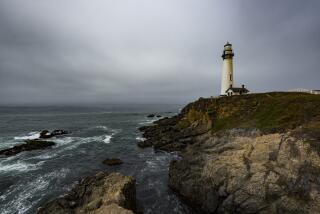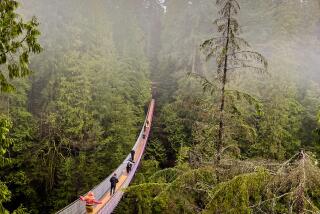‘City of Destiny,’ Tacoma Is Finally Destined for a Turnaround
TACOMA, Wash. — For more than 100 years--since the Klondike gold rush clinched Seattle’s dominance on Puget Sound in 1897 --this blue-collar town to the south has been the underdog.
Until lately, all the recent high-tech cash and glory had been concentrated in the Seattle area as well. Tacoma was best known for the sulfurous odor generated by its pulp-mill plants--down to one now that big timber’s heyday is past, the “aroma of Tacoma” long since reduced by filters.
But destiny finally may have arrived for the City of Destiny--a boastful moniker coined in the 1880s that recently had been considered a cruel joke.
As Seattle, 30 miles north, is choking on its success--with high real estate prices, traffic congestion among the worst in the nation and downtown development that threatens to overwhelm the city’s character and obscure its world-class views--unassuming Tacoma may finally be coming into its own.
“I tell people that everyone wants to live and work in Tacoma --they just don’t know it yet,” said Eric Cederstrand, the city’s self-appointed head cheerleader and a commercial real estate broker with Colliers International.
Actually, lots of them do know it. Thousands of Seattle workers commute daily from Tacoma, where housing prices are still within reach.
In time the pace may pick up in the other direction.
More than 100 new companies have settled here in the past two years, drawn by the real estate market, helpful local government, proximity to Seattle and Tacoma Power’s $100-million high-speed telecommunications network.
“This city has a vision and a mission. They’re reinventing the city around the business space and what I would call e-business,” said Karen Worstell, vice president of information security for Menlo Park, Calif.-based Atomic Tangerine, a venture-consulting spinoff of the Stanford Research Institute.
“The business community has a shared vision unlike anything I’ve ever seen--all focused on making this a city where companies can come and do business in the digital economy,” said Worstell, who opened the company office here in August.
Tacoma juts north into Puget Sound, with deep-port Commencement Bay to the east and the Narrows to the west, backed by the Olympic Mountains. Mt. Rainier looms on the southern horizon.
“I feel like I’ve died and gone to heaven,” Worstell said. “It’s the same fast-paced company, the same exciting work,” but at the end of the day, “I drive 18 miles to my house and sit on the deck on the water and look at the Milky Way.”
Some of the biggest skeptics about Tacoma’s prospects are longtime Tacomans.
“There’ve been so many fits and starts over the last couple decades,” said IDmicro’s Rob Grenley, who came home in 1990 to found a home-fuel business with Greg Stewart, a friend since seventh grade. Their company has evolved into a microchip technology outfit.
“Ten years ago downtown Tacoma was not a place you’d want to come home to. It was a scary place to be,” Grenley concedes.
At the local office of Advanced Telcom Group, a Santa Rosa, Calif.-based telecommunications company serving small-business users in third-tier markets, general manager Bruce Green recalls his horror on arrival at his new office here in May 1999--a ruin of a building in a blighted downtown block.
But the neighborhood has “come alive” over the past year and a half, said Green.
He considers Tacoma unique in offering an airport, a seaport, a rail port and a cyberport. No other U.S. city “has the upside potential that Tacoma has. It’s like Chicago at the turn of the century,” Green said-- the last century.
“We know we’ve turned the corner,” said City Manager Ray Corpuz--but only after 15 years of struggling with complicated Indian land claims, street crime, two waterfront Superfund sites and a decaying downtown core.
“We like to roll up our sleeves and get to the real work,” said Corpuz, a veteran city worker dressed in casual black who’s had his post since it was created 11 years ago.
While high-tech types are changing things at the upper end of the scale, warehouses near the University of Washington’s growing downtown satellite campus are drawing artists priced out of Seattle.
The city has zoned the area industrial-residential to allow “that artist live-work sort of space,” said Josie Emmons, city director of culture and tourism.
Renowned glass artist Dale Chihuly owns three buildings here and plans to use one to work on the 500-foot Chihuly Bridge of Glass, due for completion in two years, which will link downtown with the planned Museum of Glass on the Thea Foss Waterway.
“What’s extraordinary about Tacoma is that warehouse district . . . and its proximity to the water and Thea Foss,” said Chihuly, a Tacoma native who now lives in Seattle.
He figures Tacoma’s renaissance was inevitable, and he credits the hard times with preventing destruction of the vestiges of old Tacoma that give downtown its charm. Had prosperity come sooner, the vintage buildings might all have been torn down--as some were--in the name of progress.
He bemoaned this year’s failed effort to remove the decaying, red-brick Albers Mill, next to the glass museum site.
After considerable effort by preservation-minded developers and local fans, it’s being restored.
“When that area’s finished,” Chihuly said, “everybody’s going to see how beautiful Albers Mill is.”
What Is Tacoma’s Appeal?
* Commercial real estate prices that average about half Seattle’s. Prime downtown commercial space leases for as little as $19 a square foot, compared with about $45 in Seattle, and sells for $50 to $60 per square foot in Tacoma, compared with $100 to $120 in Seattle. In September, the average single-family home price was $288,000 in Seattle, $206,000 in Tacoma.
* The nation’s largest city-owned high-speed telecommunications system, Tacoma Power’s Click! Network, a $100-million investment conceived in 1992 that went online in 1998.
* A book of city building codes that has been slimmed down from 70 pages to seven, and a city pledge that building permits will be processed within 90 days or you get your money back.
* Manageable scale, with a metro area population of 700,000. Seattle’s metro population is 3.2 million.
* Just 30 miles from Seattle, 15 miles from Seattle-Tacoma International Airport.
* An inclusive and enthusiastic local business community, with networking groups including the Chamber of Commerce, the Tacoma Technology Consortium, the Tacoma Network and its own chapter of the Washington Software Alliance.
* Views of Commencement Bay and other reaches of Puget Sound, as well as the Olympic and Cascade mountains and looming Mt. Rainier, known to the region’s Puyallup and Nisqually tribes as “Tahoma,” roughly translated as the source of water and life.
* The growing downtown satellite campus of the University of Washington, and two venerable private colleges, the University of Puget Sound and Pacific Lutheran University.
* A new downtown convention center, a public-private project scheduled for completion in 2002.
*
City of Tacoma:
https://www.cityoftacoma.org/
More to Read
Inside the business of entertainment
The Wide Shot brings you news, analysis and insights on everything from streaming wars to production — and what it all means for the future.
You may occasionally receive promotional content from the Los Angeles Times.










